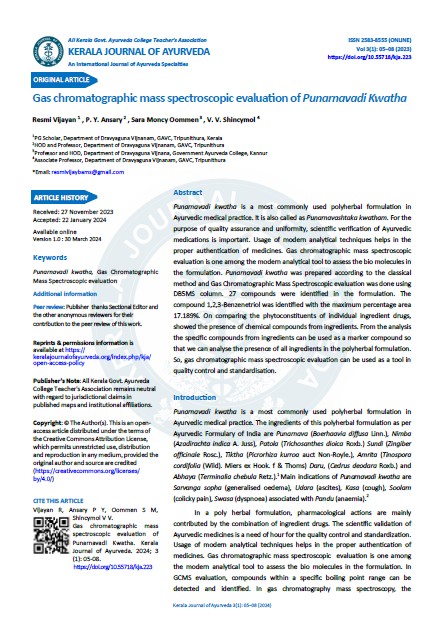Gas chromatographic mass spectroscopic evaluation of Punarnavadi Kwatha
DOI:
https://doi.org/10.55718/kja.223Keywords:
Punarnavadi kwatha, Gas Chromatographic Mass Spectroscopic evaluationAbstract
Punarnavadi kwatha is a most commonly used polyherbal formulation in Ayurvedic medical practice. It is also called as Punarnavashtaka kwatham. For the purpose of quality assurance and uniformity, scientific verification of Ayurvedic medications is important. Usage of modern analytical techniques helps in the proper authentication of medicines. Gas chromatographic mass spectroscopic evaluation is one among the modern analytical tool to assess the bio molecules in the formulation. Punarnavadi kwatha was prepared according to the classical method and Gas Chromatographic Mass Spectroscopic evaluation was done using DB5MS column. 27 compounds were identified in the formulation. The compound 1,2,3-Benzenetriol was identified with the maximum percentage area 17.189%. On comparing the phytoconstituents of individual ingredient drugs, showed the presence of chemical compounds from ingredients. From the analysis the specific compounds from ingredients can be used as a marker compound so that we can analyse the presence of all ingredients in the polyherbal formulation. So, gas chromatographic mass spectroscopic evaluation can be used as a tool in quality control and standardisation.
References
Ministry of Health and Family welfare. The Ayurvedic Formulary of India.1st edition. Government of India, Part 1, A.p.182-183
Chakrapani. Chakradatta, Sivadasa Sen(ed), trans-Pandita kulapathy V A Upadhikaadikari, Choukhambha orientalia Varanasi,;Sotha chikitsa,sloga no.11, p.470
A.Shanmugapriya ,S.Maneemegalai. Quantitative Phytochemical Estimation and GC-MS studies in Ethanolic Root Extracts of Boerhavia diffusa. International Journal of Green and Herbal Chemistry. 18 February 2018; Volume-7, No.1, 010-016; DOI: 10.24214/IJGHC/GC/7/1/01016.
R. Kavitha phytochemical screening and gc-ms analysis of bioactive compounds present in ethanolic extracts of leaf and fruit of trichosanthesis dioica roxb. International journal of pharmaceutical sciences and research. Volume 12, Issue 5,2021 May DOI: 10.13040/IJPSR.0975-8232.12(5).275
Juhi Chaudhary, Dimple Raina, Pallavi Rawat, Vidya Chauhan and Neha Chauhan GC-MS Profiling and Analysis of Bioprotective Properties of Terminalia chebula against Non-Fermenting GramNegative Bacteria Isolated from Tertiary Care Hospital. Scientific temper. 2022 January; Volume 13, No.1.
Anita Sinha. P. Sharma, Binod Singh and Amit Patnaik phytochemical studies of methanol extracts of tinospora cordifolia stem by gc-ms. World Journal of Pharmaceutical Research. 18 March 2017; Volume 6, Issue 4, 1319-1326; DOI: 10.20959/ wjpr20174-8205





